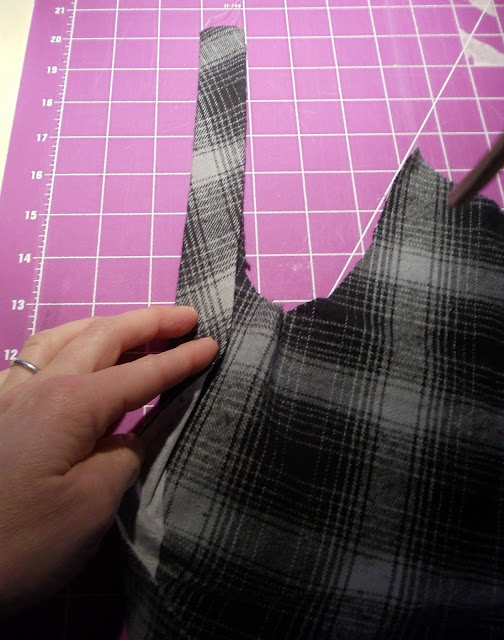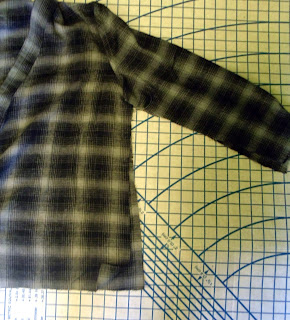So here we are! We have made ourselves a pattern in Part I, and now I'm going crazy with anticipation about getting this top constructed and on my person. Let's get to it!
Assemble your stuff:
- Iron and ironing board
- fabric cutting scissors
- pins
- tape measure
- washable marker
- pattern weights, heavy washers or canned goods
- 2 1/2 to 3 yards of 42/44" wide plaid flannel, washed, dried and pressed
- good thread
- fusible interfacing
- 15-20 prong snaps
- your pattern from Part I
A NOTE ABOUT YOUR FLANNEL CHOICE:
Pick a quality flannel that looks the same on both sides. It is important to this project as the cowl will show both sides of the fabric. Plus, it is just nicer to work with quality stuff, like good fabric, new needles, good thread, etc. I'm not going to tell you to throw out your old, bent pins or your ancient needles, but it is an investment of your time and effort....so why get cheap on that stuff?
TIP THAT IS GOING TO SOUND PREACHY: and that is the importance of having a steam iron. If you think you can skip pressing your seams and folds, be prepared to look at your finished product and say "gosh, I wish I was better at sewing." An iron is an essential tool in home sewing: haul out that ironing board and set it up!
Let's start cutting!
CUT YOUR FABRIC: On a large, flat surface, lay out your washed/dried/pressed flannel. You want to spend some time figuring out your pattern piece placement so all your pieces have the same direction. Prioritize matching the plaid on the front pieces, then work with your "cut on fold" pieces. Pay attention to grain lines, but you probably already know that! I'm sorry I can't give you an exact fabric yardage; in my case, 2 1/2 yards of 44" width flannel works. The original pattern yardage is a good guideline and add 1/2 yard extra for the cowl.
 |
| RIGHT FRONT & LEFT FRONT |
Once you have your pattern pieces arranged, weight down the heavy paper pattern pieces and trace around them with your washable marker, including markings. Pin tissue pattern pieces if you like. Take a deep breath and start cutting! For ease of future discussions, lets name our FRONT pieces: nothing special, just RIGHT FRONT and LEFT FRONT. Right front is the bigger piece and crosses the chest to overlap left front; left front is smaller and will have the receiving snaps. Moving on.
 |
| Line up the fronts so the plaid is matching at the shoulders. |
 |
| Trace around with chalk or a washable marker |
 |
| Ready to cut inside chalk lines! |
 |
| Pattern marks: make a 1/4 snip in the fabric at mark. |
 |
| I cut my cuffs on the bias for a little design detail |
1. STAY STITCH THE DIAGONAL EDGES ON RIGHT FRONT AND LEFT FRONT. Since the cut is on the bias, it will want to stretch. You don't want that.
 2. SNAP PLACKETS: We are going to apply interfacing to the front pieces. Take your pattern piece named SNAP PLACKET and cut 1 of interfacing. While you have your interfacing out, cut another piece out: make it 1 1/2 inches wide and about 30 inches long.
2. SNAP PLACKETS: We are going to apply interfacing to the front pieces. Take your pattern piece named SNAP PLACKET and cut 1 of interfacing. While you have your interfacing out, cut another piece out: make it 1 1/2 inches wide and about 30 inches long.  Take your fabric SNAP PLACKET and place the interfacing SNAP PLACKET with the smooth, nonsticky side on the right side of the fabric SNAP PLACKET.
Take your fabric SNAP PLACKET and place the interfacing SNAP PLACKET with the smooth, nonsticky side on the right side of the fabric SNAP PLACKET.  Turn the interfacing over so the sticky side is on the wrong side of the fabric: fuse the interfacing to the fabric using your steam iron and following manufacturer directions. This is an efficient way to do interfacing while taking care of raw edges.
Turn the interfacing over so the sticky side is on the wrong side of the fabric: fuse the interfacing to the fabric using your steam iron and following manufacturer directions. This is an efficient way to do interfacing while taking care of raw edges.  |
| Interfaced SNAP PLACKET, raw edges fused inside. |
Take your interfaced SNAP PLACKET and place it on the diagonal front line of the LEFT FRONT. Pin. Stitch in place with a 1/4 inch seam, stopping 1 1/4 inch from the top, just short of the shoulder seam. Fold SNAP PLACKET to inside and press seam.
Working on the RIGHT FRONT of the top, shown here on the left, take your 1 1/2 interfacing strip that you cut out and place the nonsticky side along the long diagonal edge on the right side of the RIGHT FRONT. Stitch a scant 1/4 inch seam along the edge; fold interfacing over to the wrong side and apply steam to interfacing to fuse in place. Now, fold the interfaced portion over 1 inch to the inside and press; open it up again, feel free to now admire your nice fold line you just pressed.
 |
| Interfaced RIGHT FRONT, folded under 1 inch. |
3. SHOULDER SEAMS: With right sides together, lay out your FRONT RIGHT and FRONT LEFT pieces on the BACK piece, matching any shoulder marks that came with the original pattern. Stitch shoulder seams, using a 5/8 inch seam. This is the part that is your choice: you can either do your seam, press it open and forget it, or you can do a flat-felled seam. If you are unfamiliar, there is a wonderful tutorial at http://www.coletterie.com/tutorials-tips-tricks/standard-flat-felled-seam with details. I prefer to take the time and do a flat-felled seam, but I'm not going to get bossy about it. http://www.sew4home.com/tips-resources/sewing-tips-tricks/weekend-wonders-fabriccom-how-make-flat-felled-seams would be another great flat-felled seam instruction.
 |
 |
| Flat-felled shoulder seam |
ANOTHER PREACHY SOUNDING TIP, BECAUSE I CARE: clip those threads right down to the nub as you go. Don't wait. Having hanging threads is annoying, especially at the end when you are excited to put your new top on and have to go and find all your long threads.
4. SLEEVES: I personally prefer to sew the sleeves on at this point rather than "setting in the sleeves". I also like to do a flat-felled seam on the sleeves, even though it is tricky on a curve. Follow your pattern directions and any marks from the pattern to get your sleeves attached now. Cuffs are a detail you want to keep in mind: they snap on the outside of your wrist. Make sure your sleeves are on the correct side to reflect this.
 |
| matching up the sleeves to fronts and backs |
 |
| pinning in preparation for flat-felled seam. |
 |
| Pressing the flat-felled seam |
 |
| Finished shoulder flat-felled seam. Yay!
5. SIDE SEAMS: The pattern directions will tell you to lay blouse front on blouse back, right sides together, matching marks. Baste. Stitch. I'll tell you to do that, and keep on going, pivoting as you go into sleeve territory. So now you have a side seam and and your sleeve is a sleeve. A clean finish is nice. Make yourself proud by finishing those edges. If you are unfamiliar with finishing edges, check out http://sewmamasew.com/blog2/2008/05/seam-finishes-simplified/. I really like any of these finishes, but am partial to the Clean Finish Edge. Check them out! Oh, and press those seams open!!!
I laid my top out flat and straightened it out, lining up my front snap plackets so they overlapped like they will on the finished product. The overlapping placket (RIGHT FRONT) was too long at the top, so I trimmed it so it was level with left shoulder seam. Lay your top out and do the same. |
 |
| Add caption |
 6. CUFFS: Follow the pattern directions for stitching your cuff to the sleeve. There is probably a placket (I finished mine with bias tape) and some tucks involved. This part is pretty much between you and your pattern. Go ahead....I'll wait.
6. CUFFS: Follow the pattern directions for stitching your cuff to the sleeve. There is probably a placket (I finished mine with bias tape) and some tucks involved. This part is pretty much between you and your pattern. Go ahead....I'll wait.
Stick a fork in you, you are done! Victory squeal! Wear with pride, and I would love to see pictures if you get the notion. I hope this was helpful and rewarding, and do let me know if you have a suggestion or an edit that would clarify anything. Much love to you all :)














































I'm scrolling thinking, 'what a great tutorial!' and then I noticed you have the same ironing board cover as I do! Is yours a table top dealie that randomly collapses and tries to cut off your finger also?
ReplyDeleteGreat stuff here, thank you for sharing with all of us.
tabletop dealie indeed! Handy, small, and doubles as a diving board when my kids get ahold of it! Thanks, Charity, for the love.....always love your work as well!
Delete